Fitness Program Development: Personalized Training and Evaluation
VerifiedAdded on 2020/05/28
|18
|3924
|87
Practical Assignment
AI Summary
This assignment details the development of personalized fitness programs for three clients, each with distinct goals. The first client aims to treat upper crossed syndrome, incorporating anaerobic training with exercises like bench presses, squats, and deadlifts. The second client focuses on increasing body weight and muscle tone through a beginner-level program with incremental weight increases and a focus on proper form. The third client seeks a smaller waist and flat belly, utilizing anaerobic training with exercises such as Bird Dog Crunches and planks. The assignment includes program phases, training types, equipment, detailed exercise instructions, reps, sets, and motivational techniques. It also evaluates the suitability of the programs, highlighting the importance of client satisfaction, intensity monitoring, and potential modifications. The evaluation covers aerobic and muscular strength training, emphasizing the need for personalized exercise selection, appropriate intensity levels, and continuous adaptation to meet evolving client needs. The assignment provides a comprehensive guide to fitness program design, implementation, and evaluation.
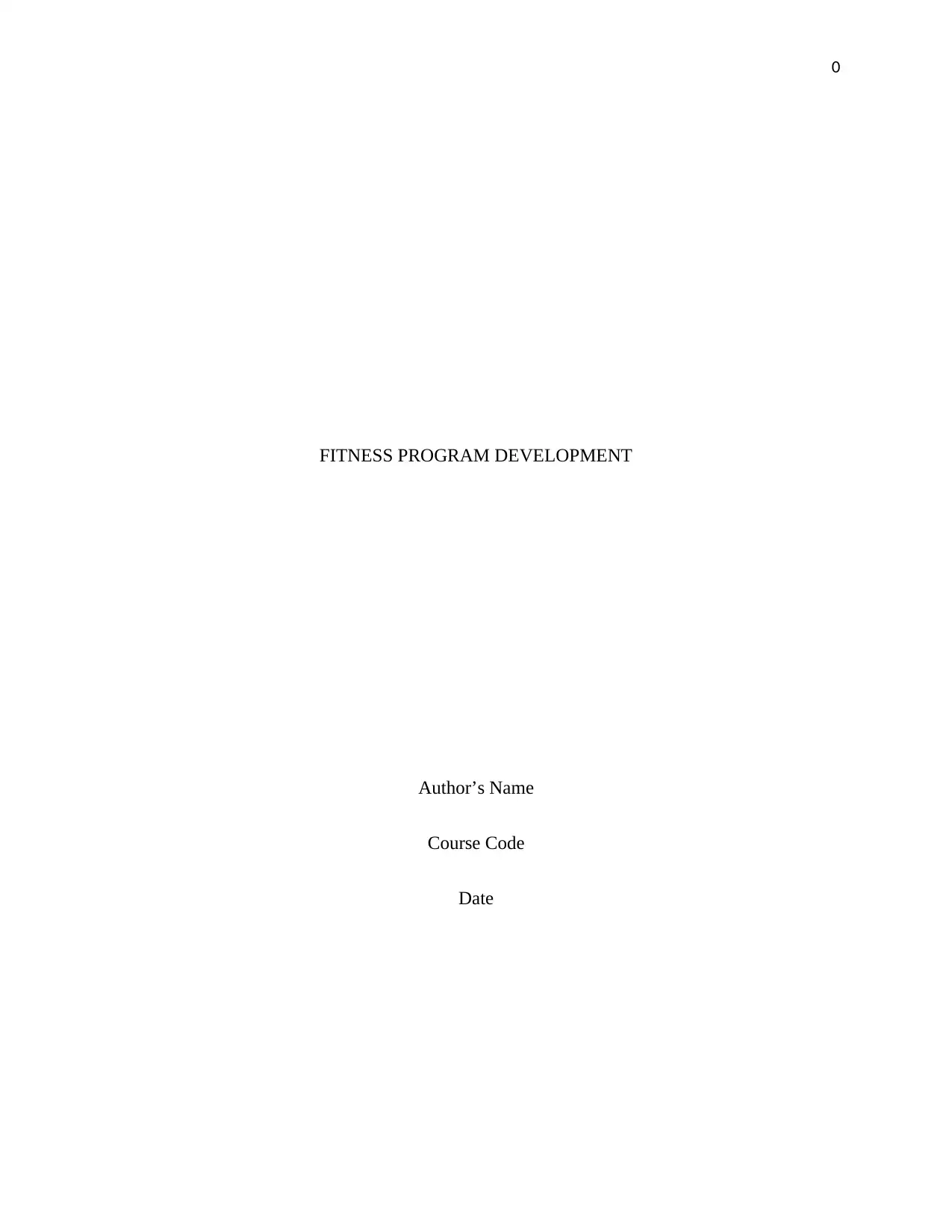
0
FITNESS PROGRAM DEVELOPMENT
Author’s Name
Course Code
Date
FITNESS PROGRAM DEVELOPMENT
Author’s Name
Course Code
Date
Paraphrase This Document
Need a fresh take? Get an instant paraphrase of this document with our AI Paraphraser
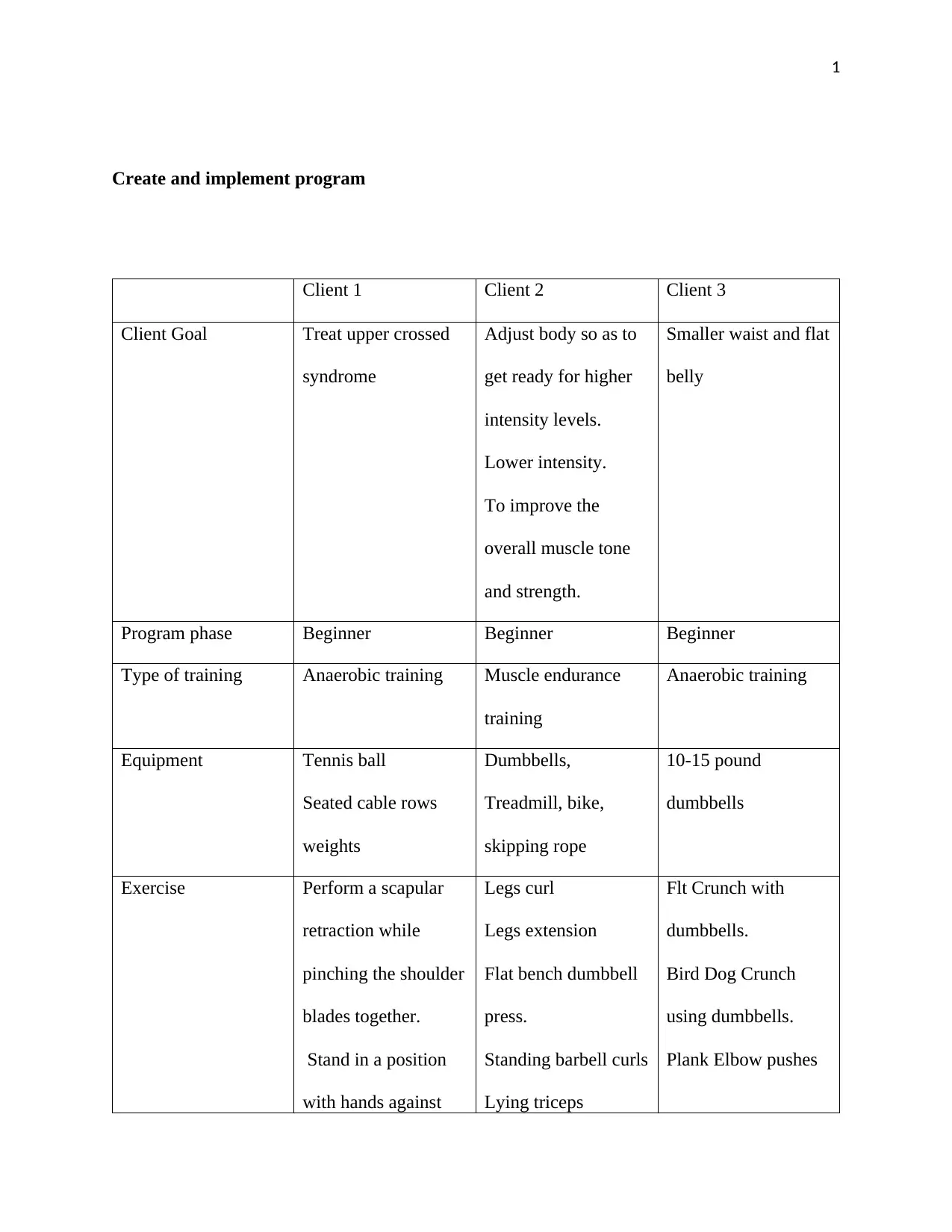
1
Create and implement program
Client 1 Client 2 Client 3
Client Goal Treat upper crossed
syndrome
Adjust body so as to
get ready for higher
intensity levels.
Lower intensity.
To improve the
overall muscle tone
and strength.
Smaller waist and flat
belly
Program phase Beginner Beginner Beginner
Type of training Anaerobic training Muscle endurance
training
Anaerobic training
Equipment Tennis ball
Seated cable rows
weights
Dumbbells,
Treadmill, bike,
skipping rope
10-15 pound
dumbbells
Exercise Perform a scapular
retraction while
pinching the shoulder
blades together.
Stand in a position
with hands against
Legs curl
Legs extension
Flat bench dumbbell
press.
Standing barbell curls
Lying triceps
Flt Crunch with
dumbbells.
Bird Dog Crunch
using dumbbells.
Plank Elbow pushes
Create and implement program
Client 1 Client 2 Client 3
Client Goal Treat upper crossed
syndrome
Adjust body so as to
get ready for higher
intensity levels.
Lower intensity.
To improve the
overall muscle tone
and strength.
Smaller waist and flat
belly
Program phase Beginner Beginner Beginner
Type of training Anaerobic training Muscle endurance
training
Anaerobic training
Equipment Tennis ball
Seated cable rows
weights
Dumbbells,
Treadmill, bike,
skipping rope
10-15 pound
dumbbells
Exercise Perform a scapular
retraction while
pinching the shoulder
blades together.
Stand in a position
with hands against
Legs curl
Legs extension
Flat bench dumbbell
press.
Standing barbell curls
Lying triceps
Flt Crunch with
dumbbells.
Bird Dog Crunch
using dumbbells.
Plank Elbow pushes
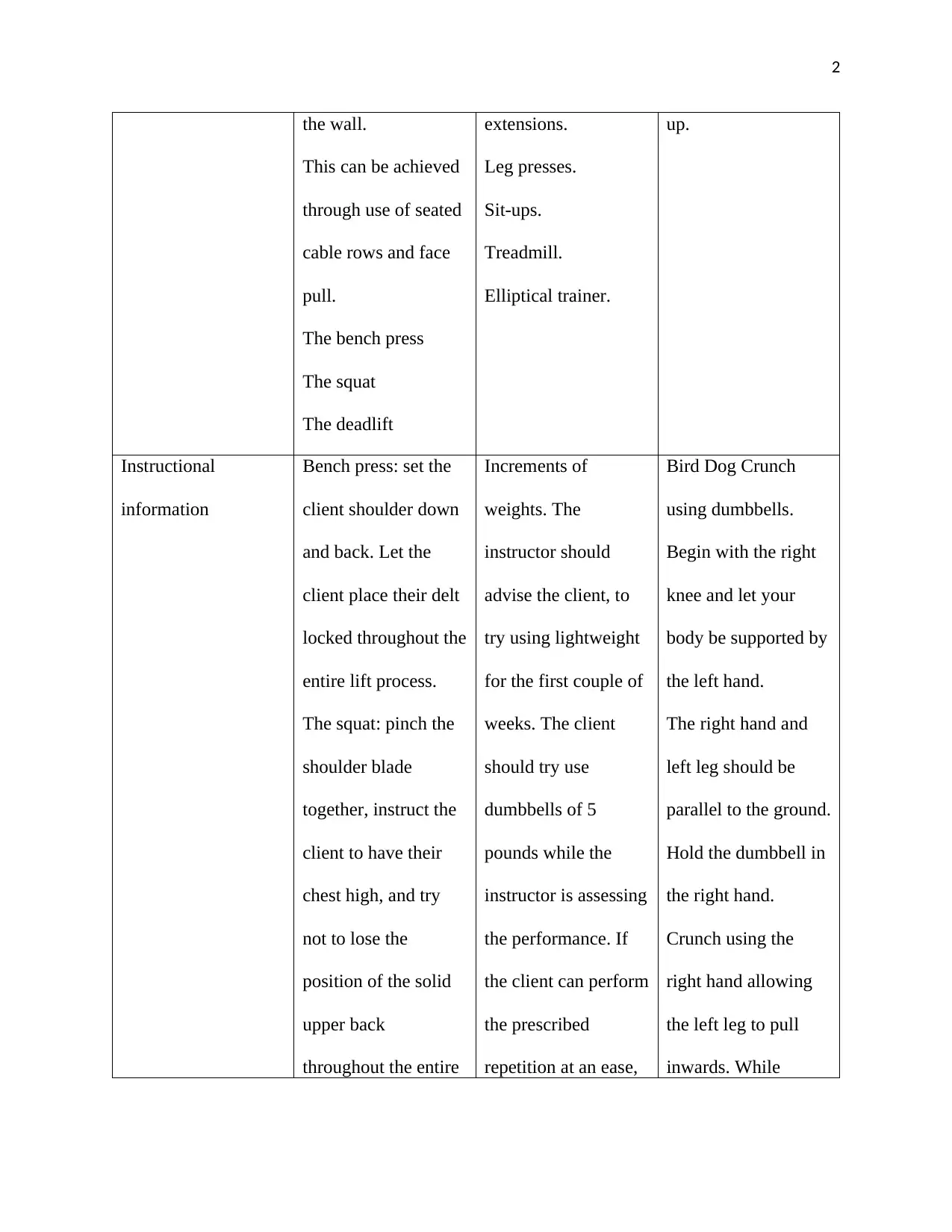
2
the wall.
This can be achieved
through use of seated
cable rows and face
pull.
The bench press
The squat
The deadlift
extensions.
Leg presses.
Sit-ups.
Treadmill.
Elliptical trainer.
up.
Instructional
information
Bench press: set the
client shoulder down
and back. Let the
client place their delt
locked throughout the
entire lift process.
The squat: pinch the
shoulder blade
together, instruct the
client to have their
chest high, and try
not to lose the
position of the solid
upper back
throughout the entire
Increments of
weights. The
instructor should
advise the client, to
try using lightweight
for the first couple of
weeks. The client
should try use
dumbbells of 5
pounds while the
instructor is assessing
the performance. If
the client can perform
the prescribed
repetition at an ease,
Bird Dog Crunch
using dumbbells.
Begin with the right
knee and let your
body be supported by
the left hand.
The right hand and
left leg should be
parallel to the ground.
Hold the dumbbell in
the right hand.
Crunch using the
right hand allowing
the left leg to pull
inwards. While
the wall.
This can be achieved
through use of seated
cable rows and face
pull.
The bench press
The squat
The deadlift
extensions.
Leg presses.
Sit-ups.
Treadmill.
Elliptical trainer.
up.
Instructional
information
Bench press: set the
client shoulder down
and back. Let the
client place their delt
locked throughout the
entire lift process.
The squat: pinch the
shoulder blade
together, instruct the
client to have their
chest high, and try
not to lose the
position of the solid
upper back
throughout the entire
Increments of
weights. The
instructor should
advise the client, to
try using lightweight
for the first couple of
weeks. The client
should try use
dumbbells of 5
pounds while the
instructor is assessing
the performance. If
the client can perform
the prescribed
repetition at an ease,
Bird Dog Crunch
using dumbbells.
Begin with the right
knee and let your
body be supported by
the left hand.
The right hand and
left leg should be
parallel to the ground.
Hold the dumbbell in
the right hand.
Crunch using the
right hand allowing
the left leg to pull
inwards. While
⊘ This is a preview!⊘
Do you want full access?
Subscribe today to unlock all pages.

Trusted by 1+ million students worldwide
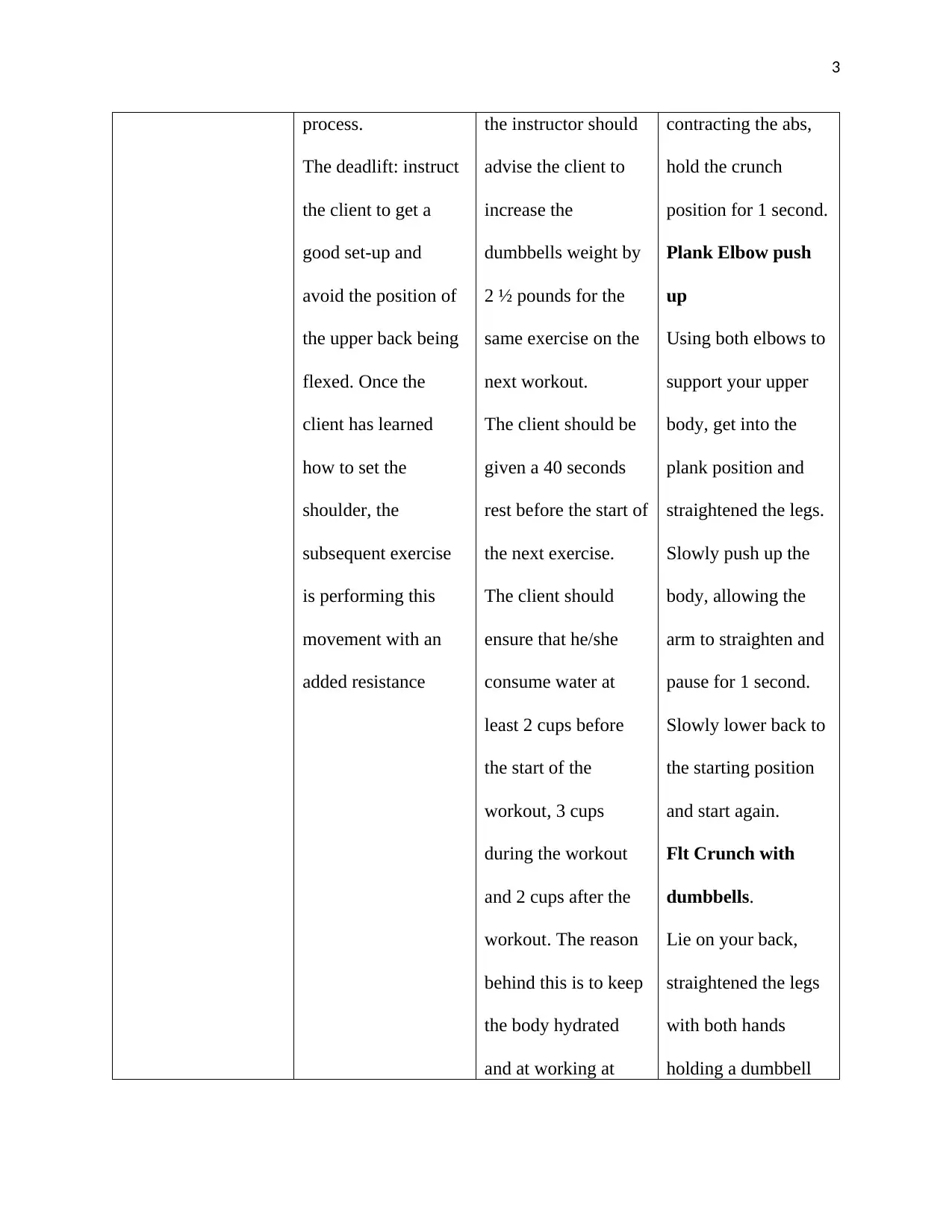
3
process.
The deadlift: instruct
the client to get a
good set-up and
avoid the position of
the upper back being
flexed. Once the
client has learned
how to set the
shoulder, the
subsequent exercise
is performing this
movement with an
added resistance
the instructor should
advise the client to
increase the
dumbbells weight by
2 ½ pounds for the
same exercise on the
next workout.
The client should be
given a 40 seconds
rest before the start of
the next exercise.
The client should
ensure that he/she
consume water at
least 2 cups before
the start of the
workout, 3 cups
during the workout
and 2 cups after the
workout. The reason
behind this is to keep
the body hydrated
and at working at
contracting the abs,
hold the crunch
position for 1 second.
Plank Elbow push
up
Using both elbows to
support your upper
body, get into the
plank position and
straightened the legs.
Slowly push up the
body, allowing the
arm to straighten and
pause for 1 second.
Slowly lower back to
the starting position
and start again.
Flt Crunch with
dumbbells.
Lie on your back,
straightened the legs
with both hands
holding a dumbbell
process.
The deadlift: instruct
the client to get a
good set-up and
avoid the position of
the upper back being
flexed. Once the
client has learned
how to set the
shoulder, the
subsequent exercise
is performing this
movement with an
added resistance
the instructor should
advise the client to
increase the
dumbbells weight by
2 ½ pounds for the
same exercise on the
next workout.
The client should be
given a 40 seconds
rest before the start of
the next exercise.
The client should
ensure that he/she
consume water at
least 2 cups before
the start of the
workout, 3 cups
during the workout
and 2 cups after the
workout. The reason
behind this is to keep
the body hydrated
and at working at
contracting the abs,
hold the crunch
position for 1 second.
Plank Elbow push
up
Using both elbows to
support your upper
body, get into the
plank position and
straightened the legs.
Slowly push up the
body, allowing the
arm to straighten and
pause for 1 second.
Slowly lower back to
the starting position
and start again.
Flt Crunch with
dumbbells.
Lie on your back,
straightened the legs
with both hands
holding a dumbbell
Paraphrase This Document
Need a fresh take? Get an instant paraphrase of this document with our AI Paraphraser
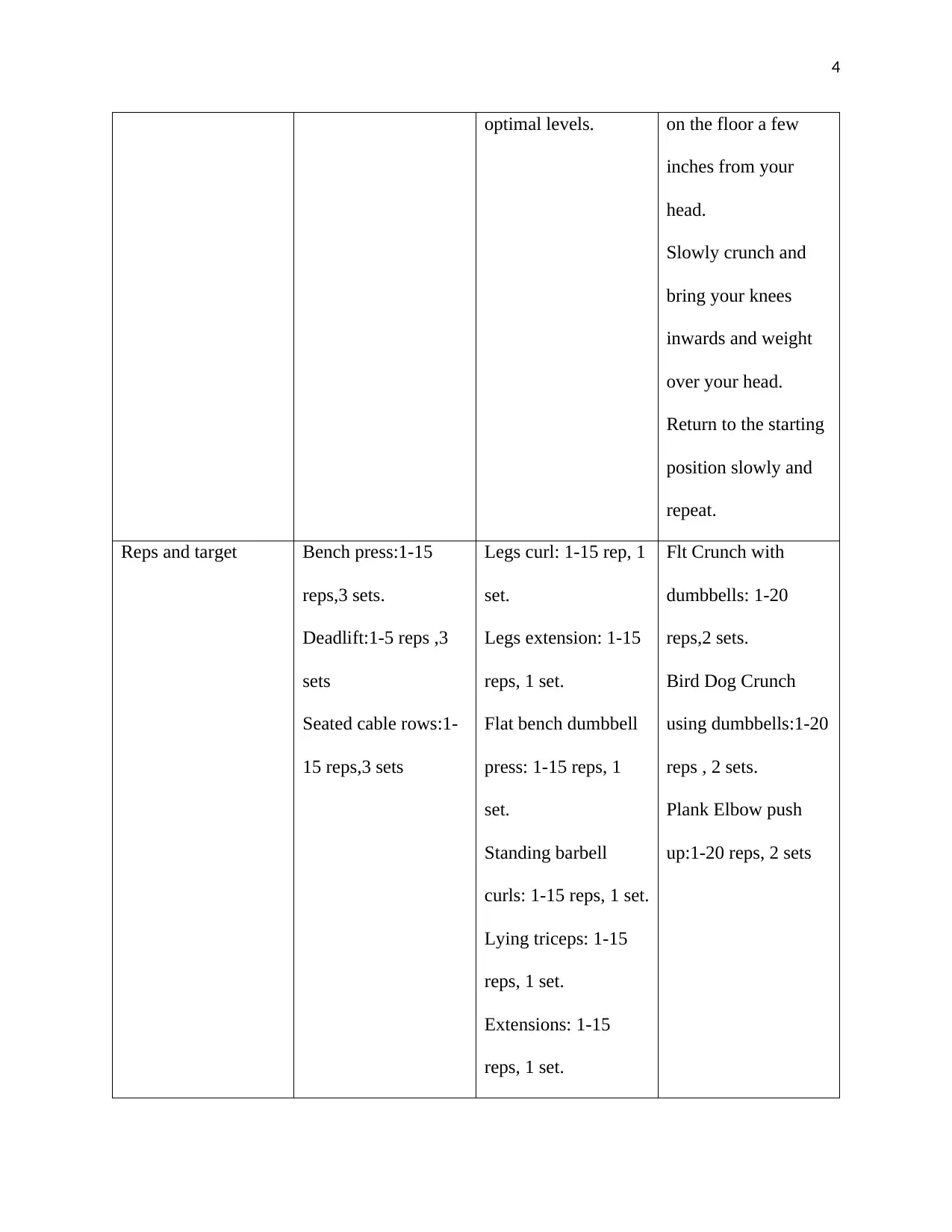
4
optimal levels. on the floor a few
inches from your
head.
Slowly crunch and
bring your knees
inwards and weight
over your head.
Return to the starting
position slowly and
repeat.
Reps and target Bench press:1-15
reps,3 sets.
Deadlift:1-5 reps ,3
sets
Seated cable rows:1-
15 reps,3 sets
Legs curl: 1-15 rep, 1
set.
Legs extension: 1-15
reps, 1 set.
Flat bench dumbbell
press: 1-15 reps, 1
set.
Standing barbell
curls: 1-15 reps, 1 set.
Lying triceps: 1-15
reps, 1 set.
Extensions: 1-15
reps, 1 set.
Flt Crunch with
dumbbells: 1-20
reps,2 sets.
Bird Dog Crunch
using dumbbells:1-20
reps , 2 sets.
Plank Elbow push
up:1-20 reps, 2 sets
optimal levels. on the floor a few
inches from your
head.
Slowly crunch and
bring your knees
inwards and weight
over your head.
Return to the starting
position slowly and
repeat.
Reps and target Bench press:1-15
reps,3 sets.
Deadlift:1-5 reps ,3
sets
Seated cable rows:1-
15 reps,3 sets
Legs curl: 1-15 rep, 1
set.
Legs extension: 1-15
reps, 1 set.
Flat bench dumbbell
press: 1-15 reps, 1
set.
Standing barbell
curls: 1-15 reps, 1 set.
Lying triceps: 1-15
reps, 1 set.
Extensions: 1-15
reps, 1 set.
Flt Crunch with
dumbbells: 1-20
reps,2 sets.
Bird Dog Crunch
using dumbbells:1-20
reps , 2 sets.
Plank Elbow push
up:1-20 reps, 2 sets
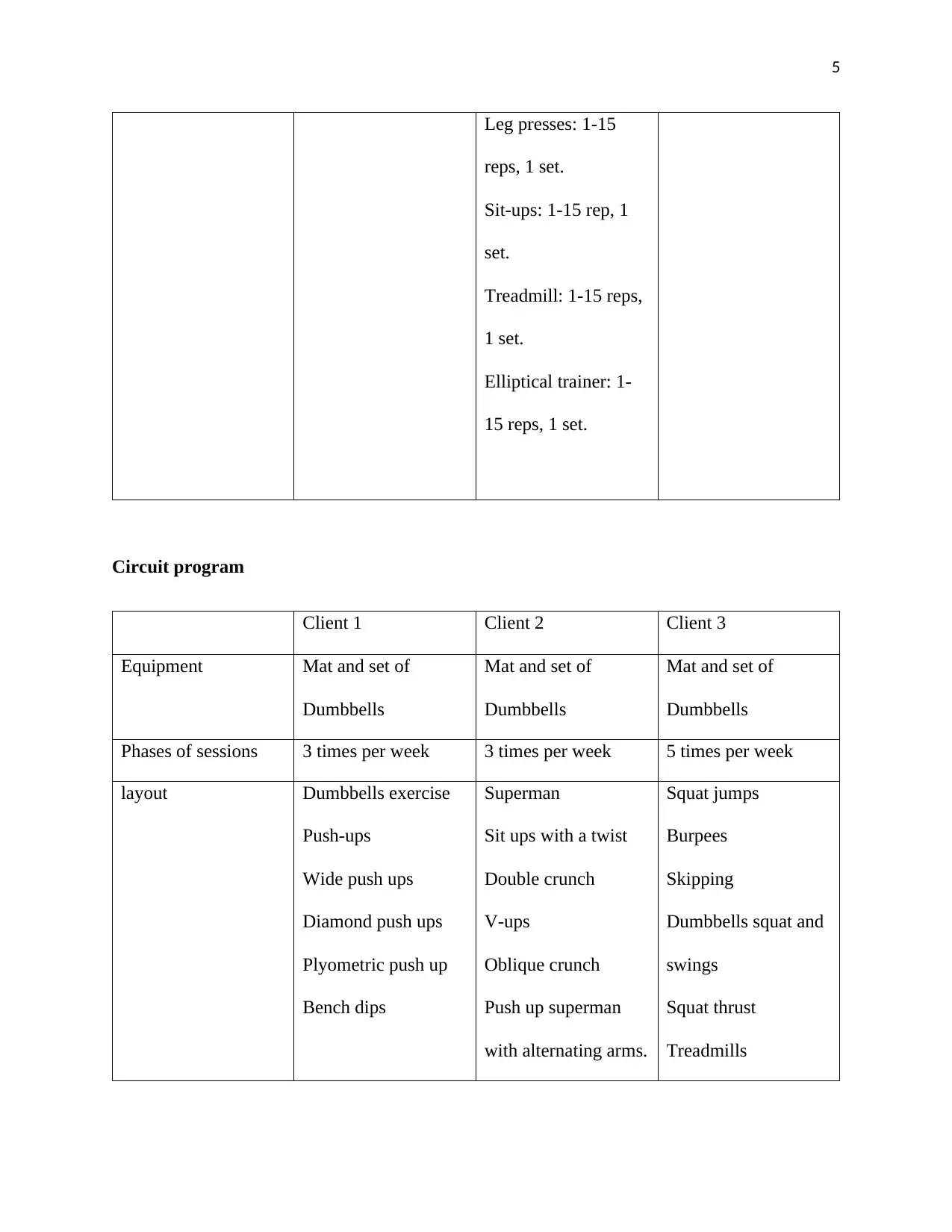
5
Leg presses: 1-15
reps, 1 set.
Sit-ups: 1-15 rep, 1
set.
Treadmill: 1-15 reps,
1 set.
Elliptical trainer: 1-
15 reps, 1 set.
Circuit program
Client 1 Client 2 Client 3
Equipment Mat and set of
Dumbbells
Mat and set of
Dumbbells
Mat and set of
Dumbbells
Phases of sessions 3 times per week 3 times per week 5 times per week
layout Dumbbells exercise
Push-ups
Wide push ups
Diamond push ups
Plyometric push up
Bench dips
Superman
Sit ups with a twist
Double crunch
V-ups
Oblique crunch
Push up superman
with alternating arms.
Squat jumps
Burpees
Skipping
Dumbbells squat and
swings
Squat thrust
Treadmills
Leg presses: 1-15
reps, 1 set.
Sit-ups: 1-15 rep, 1
set.
Treadmill: 1-15 reps,
1 set.
Elliptical trainer: 1-
15 reps, 1 set.
Circuit program
Client 1 Client 2 Client 3
Equipment Mat and set of
Dumbbells
Mat and set of
Dumbbells
Mat and set of
Dumbbells
Phases of sessions 3 times per week 3 times per week 5 times per week
layout Dumbbells exercise
Push-ups
Wide push ups
Diamond push ups
Plyometric push up
Bench dips
Superman
Sit ups with a twist
Double crunch
V-ups
Oblique crunch
Push up superman
with alternating arms.
Squat jumps
Burpees
Skipping
Dumbbells squat and
swings
Squat thrust
Treadmills
⊘ This is a preview!⊘
Do you want full access?
Subscribe today to unlock all pages.

Trusted by 1+ million students worldwide

6
Bicycle kicks High knees
Number of
participants
1 1 1
Group training program
AEROBIC Muscular strength
Appropriate phase, exercise All 4 belly’s breathing 5
times
Squats to stand 8 times
Rock back T-spine rotation
6/arm
Single leg glut bridge 8/leg
KB swings
Prowler pull to push
Walking lunges
Battle ropes
Single leg hip thrust off
bench
Trap bar deadlift 5 times.
Heavy swings 10 times
Band alphabets
Split stance low cable
Slide board body saw
Music sequence Music that can be danced to. Hard rock and pop music.
Motivational techniques Set short-term goals
Track the client progress
Communicate with clients
Set short term goals
Track the client progress
Communicate with clients
Bicycle kicks High knees
Number of
participants
1 1 1
Group training program
AEROBIC Muscular strength
Appropriate phase, exercise All 4 belly’s breathing 5
times
Squats to stand 8 times
Rock back T-spine rotation
6/arm
Single leg glut bridge 8/leg
KB swings
Prowler pull to push
Walking lunges
Battle ropes
Single leg hip thrust off
bench
Trap bar deadlift 5 times.
Heavy swings 10 times
Band alphabets
Split stance low cable
Slide board body saw
Music sequence Music that can be danced to. Hard rock and pop music.
Motivational techniques Set short-term goals
Track the client progress
Communicate with clients
Set short term goals
Track the client progress
Communicate with clients
Paraphrase This Document
Need a fresh take? Get an instant paraphrase of this document with our AI Paraphraser

7
Understanding what
motivates them
Understanding what
motivates them
Modification of an existing program
Client 1 Client 2 Client 3
REPS 2-6 reps ,3 sets 2-8 reps,2 sets 2-6 reps,3 sets
Exercise Bird Dog Crunch
using dumbbells.
Plank Elbow push up
Standing barbell curls
Lying triceps
extensions.
Leg presses.
Sit ups.
Deadlift
Seated cable
Training type Aerobics Endurance Aerobics
Report on program delivery
Understanding what
motivates them
Understanding what
motivates them
Modification of an existing program
Client 1 Client 2 Client 3
REPS 2-6 reps ,3 sets 2-8 reps,2 sets 2-6 reps,3 sets
Exercise Bird Dog Crunch
using dumbbells.
Plank Elbow push up
Standing barbell curls
Lying triceps
extensions.
Leg presses.
Sit ups.
Deadlift
Seated cable
Training type Aerobics Endurance Aerobics
Report on program delivery
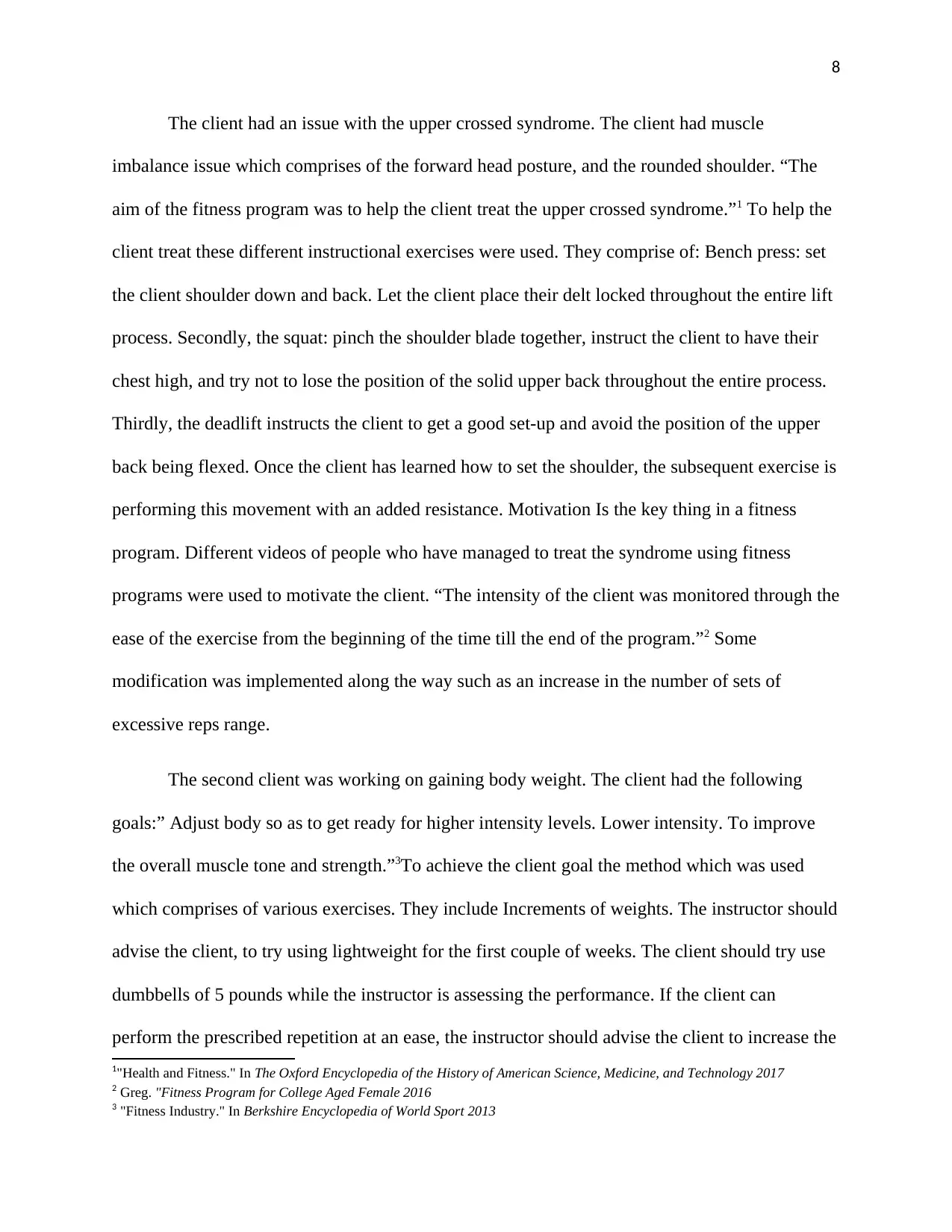
8
The client had an issue with the upper crossed syndrome. The client had muscle
imbalance issue which comprises of the forward head posture, and the rounded shoulder. “The
aim of the fitness program was to help the client treat the upper crossed syndrome.”1 To help the
client treat these different instructional exercises were used. They comprise of: Bench press: set
the client shoulder down and back. Let the client place their delt locked throughout the entire lift
process. Secondly, the squat: pinch the shoulder blade together, instruct the client to have their
chest high, and try not to lose the position of the solid upper back throughout the entire process.
Thirdly, the deadlift instructs the client to get a good set-up and avoid the position of the upper
back being flexed. Once the client has learned how to set the shoulder, the subsequent exercise is
performing this movement with an added resistance. Motivation Is the key thing in a fitness
program. Different videos of people who have managed to treat the syndrome using fitness
programs were used to motivate the client. “The intensity of the client was monitored through the
ease of the exercise from the beginning of the time till the end of the program.”2 Some
modification was implemented along the way such as an increase in the number of sets of
excessive reps range.
The second client was working on gaining body weight. The client had the following
goals:” Adjust body so as to get ready for higher intensity levels. Lower intensity. To improve
the overall muscle tone and strength.”3To achieve the client goal the method which was used
which comprises of various exercises. They include Increments of weights. The instructor should
advise the client, to try using lightweight for the first couple of weeks. The client should try use
dumbbells of 5 pounds while the instructor is assessing the performance. If the client can
perform the prescribed repetition at an ease, the instructor should advise the client to increase the
1"Health and Fitness." In The Oxford Encyclopedia of the History of American Science, Medicine, and Technology 2017
2 Greg. "Fitness Program for College Aged Female 2016
3 "Fitness Industry." In Berkshire Encyclopedia of World Sport 2013
The client had an issue with the upper crossed syndrome. The client had muscle
imbalance issue which comprises of the forward head posture, and the rounded shoulder. “The
aim of the fitness program was to help the client treat the upper crossed syndrome.”1 To help the
client treat these different instructional exercises were used. They comprise of: Bench press: set
the client shoulder down and back. Let the client place their delt locked throughout the entire lift
process. Secondly, the squat: pinch the shoulder blade together, instruct the client to have their
chest high, and try not to lose the position of the solid upper back throughout the entire process.
Thirdly, the deadlift instructs the client to get a good set-up and avoid the position of the upper
back being flexed. Once the client has learned how to set the shoulder, the subsequent exercise is
performing this movement with an added resistance. Motivation Is the key thing in a fitness
program. Different videos of people who have managed to treat the syndrome using fitness
programs were used to motivate the client. “The intensity of the client was monitored through the
ease of the exercise from the beginning of the time till the end of the program.”2 Some
modification was implemented along the way such as an increase in the number of sets of
excessive reps range.
The second client was working on gaining body weight. The client had the following
goals:” Adjust body so as to get ready for higher intensity levels. Lower intensity. To improve
the overall muscle tone and strength.”3To achieve the client goal the method which was used
which comprises of various exercises. They include Increments of weights. The instructor should
advise the client, to try using lightweight for the first couple of weeks. The client should try use
dumbbells of 5 pounds while the instructor is assessing the performance. If the client can
perform the prescribed repetition at an ease, the instructor should advise the client to increase the
1"Health and Fitness." In The Oxford Encyclopedia of the History of American Science, Medicine, and Technology 2017
2 Greg. "Fitness Program for College Aged Female 2016
3 "Fitness Industry." In Berkshire Encyclopedia of World Sport 2013
⊘ This is a preview!⊘
Do you want full access?
Subscribe today to unlock all pages.

Trusted by 1+ million students worldwide
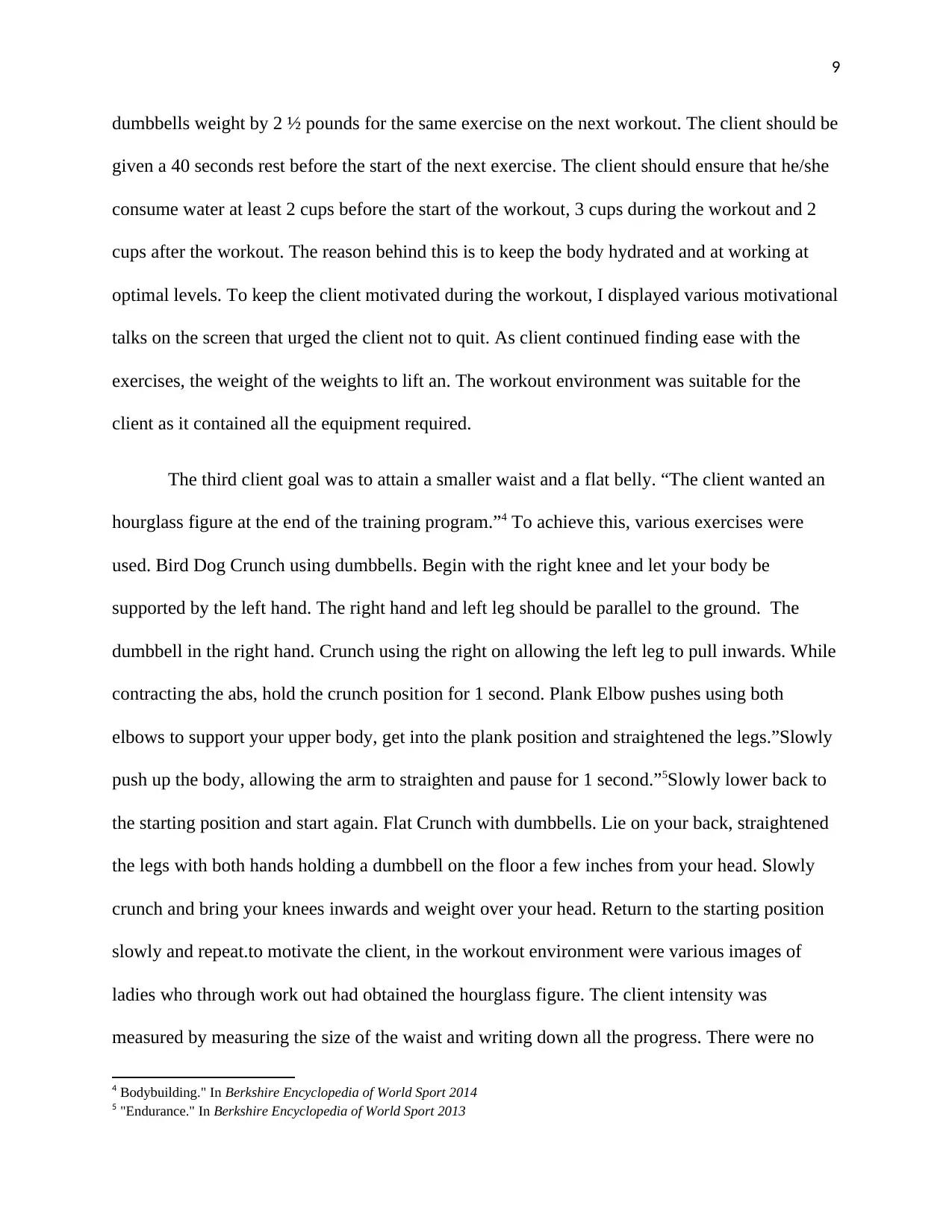
9
dumbbells weight by 2 ½ pounds for the same exercise on the next workout. The client should be
given a 40 seconds rest before the start of the next exercise. The client should ensure that he/she
consume water at least 2 cups before the start of the workout, 3 cups during the workout and 2
cups after the workout. The reason behind this is to keep the body hydrated and at working at
optimal levels. To keep the client motivated during the workout, I displayed various motivational
talks on the screen that urged the client not to quit. As client continued finding ease with the
exercises, the weight of the weights to lift an. The workout environment was suitable for the
client as it contained all the equipment required.
The third client goal was to attain a smaller waist and a flat belly. “The client wanted an
hourglass figure at the end of the training program.”4 To achieve this, various exercises were
used. Bird Dog Crunch using dumbbells. Begin with the right knee and let your body be
supported by the left hand. The right hand and left leg should be parallel to the ground. The
dumbbell in the right hand. Crunch using the right on allowing the left leg to pull inwards. While
contracting the abs, hold the crunch position for 1 second. Plank Elbow pushes using both
elbows to support your upper body, get into the plank position and straightened the legs.”Slowly
push up the body, allowing the arm to straighten and pause for 1 second.”5Slowly lower back to
the starting position and start again. Flat Crunch with dumbbells. Lie on your back, straightened
the legs with both hands holding a dumbbell on the floor a few inches from your head. Slowly
crunch and bring your knees inwards and weight over your head. Return to the starting position
slowly and repeat.to motivate the client, in the workout environment were various images of
ladies who through work out had obtained the hourglass figure. The client intensity was
measured by measuring the size of the waist and writing down all the progress. There were no
4 Bodybuilding." In Berkshire Encyclopedia of World Sport 2014
5 "Endurance." In Berkshire Encyclopedia of World Sport 2013
dumbbells weight by 2 ½ pounds for the same exercise on the next workout. The client should be
given a 40 seconds rest before the start of the next exercise. The client should ensure that he/she
consume water at least 2 cups before the start of the workout, 3 cups during the workout and 2
cups after the workout. The reason behind this is to keep the body hydrated and at working at
optimal levels. To keep the client motivated during the workout, I displayed various motivational
talks on the screen that urged the client not to quit. As client continued finding ease with the
exercises, the weight of the weights to lift an. The workout environment was suitable for the
client as it contained all the equipment required.
The third client goal was to attain a smaller waist and a flat belly. “The client wanted an
hourglass figure at the end of the training program.”4 To achieve this, various exercises were
used. Bird Dog Crunch using dumbbells. Begin with the right knee and let your body be
supported by the left hand. The right hand and left leg should be parallel to the ground. The
dumbbell in the right hand. Crunch using the right on allowing the left leg to pull inwards. While
contracting the abs, hold the crunch position for 1 second. Plank Elbow pushes using both
elbows to support your upper body, get into the plank position and straightened the legs.”Slowly
push up the body, allowing the arm to straighten and pause for 1 second.”5Slowly lower back to
the starting position and start again. Flat Crunch with dumbbells. Lie on your back, straightened
the legs with both hands holding a dumbbell on the floor a few inches from your head. Slowly
crunch and bring your knees inwards and weight over your head. Return to the starting position
slowly and repeat.to motivate the client, in the workout environment were various images of
ladies who through work out had obtained the hourglass figure. The client intensity was
measured by measuring the size of the waist and writing down all the progress. There were no
4 Bodybuilding." In Berkshire Encyclopedia of World Sport 2014
5 "Endurance." In Berkshire Encyclopedia of World Sport 2013
Paraphrase This Document
Need a fresh take? Get an instant paraphrase of this document with our AI Paraphraser

10
modifications made to the client exercise program. The workout environment was suitable as it
had all the equipment required for this fitness program.
Evaluate the programs developed for each of our client
The aerobic training type for client 1 and 3 was suitable. This is because the aerobics
exercise involved the sustained, movements that are rhythmic using large body muscles with
oxygen as the primary source of energy for the extended period of time. The reps, sets and loads
were suitable to ensure the client achieve his /her goal without causing harm to their body. The
client is at the beginner level, training at a frequency of 3-5 day per week. The intensity of the
training was deconditioned: 30-40% of the client heart rate reserve. The clients did three sets of
various exercise for 30-40 minutes per day. Some aspect of the training that required further
emphasis comprises of, the client should select the type of exercise that is more enjoyable to
them so that they can be consistent. Due to the changing needs of the fitness adaptation, the
intensity of the training should be made hard as the client continues to exercise. The fitness
programs should come up with other exercises that tackle various clients goals .the workout
environment should be made modern so that it can accommodate various clients.
The second client training type was muscular strength and endurance. “Muscular
endurance is the competencies of performing various submaximal muscular contractions with an
intensity that is sustained and the arrow. “6The muscular strength is the competencies of
performing at the client maximal intensity one reputation. The frequency of the program for the
beginner was 2-3 days per week for full body workout. The client should be allowed a minimum
6 Corbin, Charles B., Gregory J. Welk, Cheryl Richardson, Catherine Vowell, Dolly Lambdin, and Scott Wikgren. "Youth
physical fitness: Ten key concepts.2014
modifications made to the client exercise program. The workout environment was suitable as it
had all the equipment required for this fitness program.
Evaluate the programs developed for each of our client
The aerobic training type for client 1 and 3 was suitable. This is because the aerobics
exercise involved the sustained, movements that are rhythmic using large body muscles with
oxygen as the primary source of energy for the extended period of time. The reps, sets and loads
were suitable to ensure the client achieve his /her goal without causing harm to their body. The
client is at the beginner level, training at a frequency of 3-5 day per week. The intensity of the
training was deconditioned: 30-40% of the client heart rate reserve. The clients did three sets of
various exercise for 30-40 minutes per day. Some aspect of the training that required further
emphasis comprises of, the client should select the type of exercise that is more enjoyable to
them so that they can be consistent. Due to the changing needs of the fitness adaptation, the
intensity of the training should be made hard as the client continues to exercise. The fitness
programs should come up with other exercises that tackle various clients goals .the workout
environment should be made modern so that it can accommodate various clients.
The second client training type was muscular strength and endurance. “Muscular
endurance is the competencies of performing various submaximal muscular contractions with an
intensity that is sustained and the arrow. “6The muscular strength is the competencies of
performing at the client maximal intensity one reputation. The frequency of the program for the
beginner was 2-3 days per week for full body workout. The client should be allowed a minimum
6 Corbin, Charles B., Gregory J. Welk, Cheryl Richardson, Catherine Vowell, Dolly Lambdin, and Scott Wikgren. "Youth
physical fitness: Ten key concepts.2014
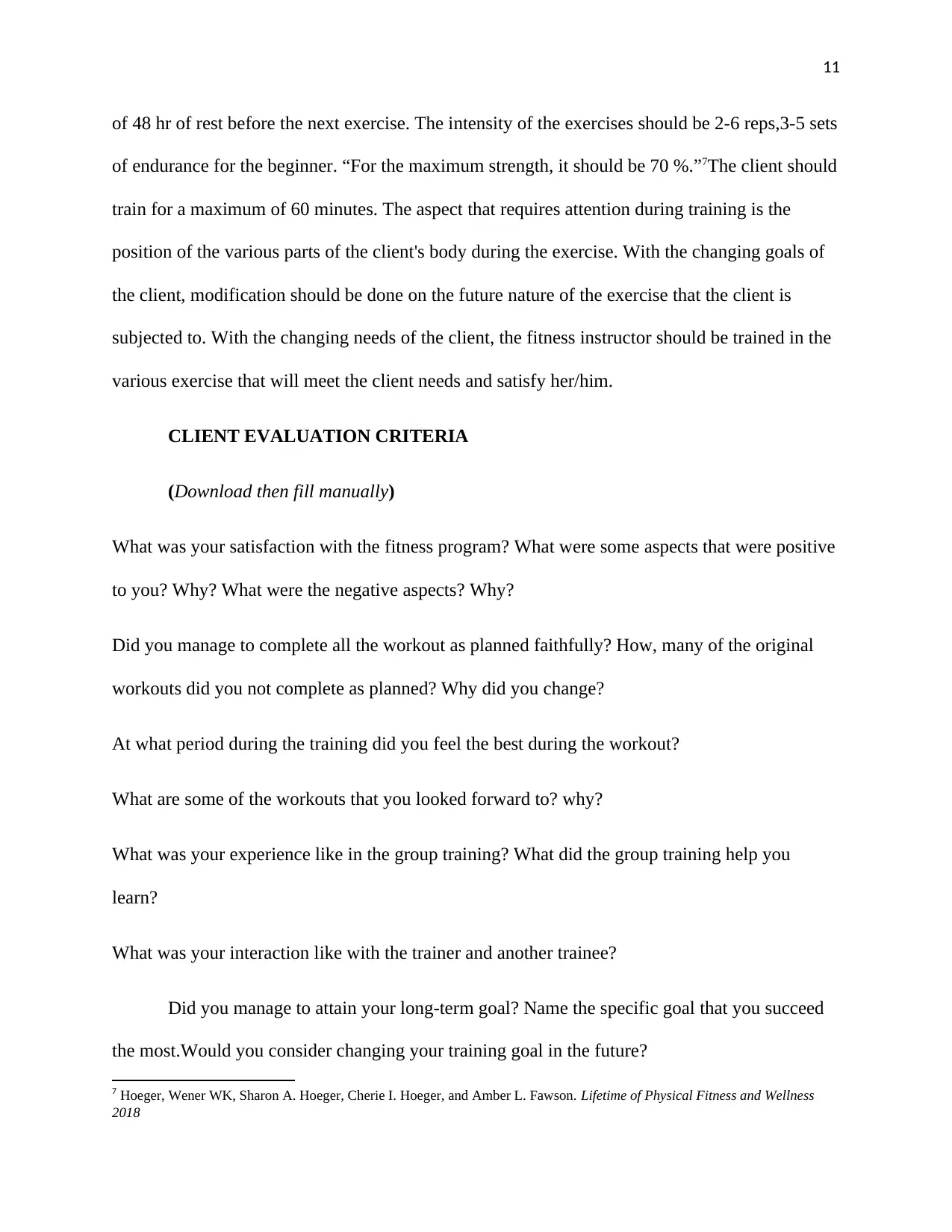
11
of 48 hr of rest before the next exercise. The intensity of the exercises should be 2-6 reps,3-5 sets
of endurance for the beginner. “For the maximum strength, it should be 70 %.”7The client should
train for a maximum of 60 minutes. The aspect that requires attention during training is the
position of the various parts of the client's body during the exercise. With the changing goals of
the client, modification should be done on the future nature of the exercise that the client is
subjected to. With the changing needs of the client, the fitness instructor should be trained in the
various exercise that will meet the client needs and satisfy her/him.
CLIENT EVALUATION CRITERIA
(Download then fill manually)
What was your satisfaction with the fitness program? What were some aspects that were positive
to you? Why? What were the negative aspects? Why?
Did you manage to complete all the workout as planned faithfully? How, many of the original
workouts did you not complete as planned? Why did you change?
At what period during the training did you feel the best during the workout?
What are some of the workouts that you looked forward to? why?
What was your experience like in the group training? What did the group training help you
learn?
What was your interaction like with the trainer and another trainee?
Did you manage to attain your long-term goal? Name the specific goal that you succeed
the most.Would you consider changing your training goal in the future?
7 Hoeger, Wener WK, Sharon A. Hoeger, Cherie I. Hoeger, and Amber L. Fawson. Lifetime of Physical Fitness and Wellness
2018
of 48 hr of rest before the next exercise. The intensity of the exercises should be 2-6 reps,3-5 sets
of endurance for the beginner. “For the maximum strength, it should be 70 %.”7The client should
train for a maximum of 60 minutes. The aspect that requires attention during training is the
position of the various parts of the client's body during the exercise. With the changing goals of
the client, modification should be done on the future nature of the exercise that the client is
subjected to. With the changing needs of the client, the fitness instructor should be trained in the
various exercise that will meet the client needs and satisfy her/him.
CLIENT EVALUATION CRITERIA
(Download then fill manually)
What was your satisfaction with the fitness program? What were some aspects that were positive
to you? Why? What were the negative aspects? Why?
Did you manage to complete all the workout as planned faithfully? How, many of the original
workouts did you not complete as planned? Why did you change?
At what period during the training did you feel the best during the workout?
What are some of the workouts that you looked forward to? why?
What was your experience like in the group training? What did the group training help you
learn?
What was your interaction like with the trainer and another trainee?
Did you manage to attain your long-term goal? Name the specific goal that you succeed
the most.Would you consider changing your training goal in the future?
7 Hoeger, Wener WK, Sharon A. Hoeger, Cherie I. Hoeger, and Amber L. Fawson. Lifetime of Physical Fitness and Wellness
2018
⊘ This is a preview!⊘
Do you want full access?
Subscribe today to unlock all pages.

Trusted by 1+ million students worldwide
1 out of 18
Your All-in-One AI-Powered Toolkit for Academic Success.
+13062052269
info@desklib.com
Available 24*7 on WhatsApp / Email
![[object Object]](/_next/static/media/star-bottom.7253800d.svg)
Unlock your academic potential
Copyright © 2020–2025 A2Z Services. All Rights Reserved. Developed and managed by ZUCOL.


